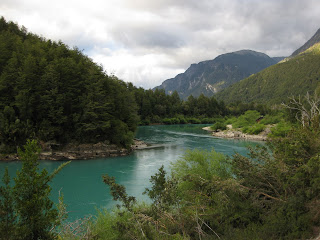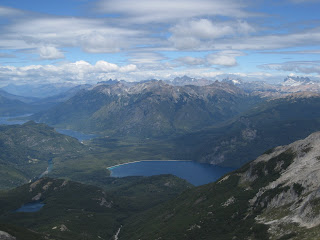Futaleufú is two things: a mountain village in Chile and one of the wildest whitewater rivers on the planet. Not much happens in the sleepy village, where woodsmoke mingles with gray skies even in the middle of summer. It's the kind of town where you buy bus tickets and used T-shirts from the woman at the post office (a wooden desk in a charmingly decrepit cottage.) On my way back to Chile I had run into Martina, a German girl I'd hiked with near Pucón six weeks earlier. We decided to join forces for some treks further south and took a bus from Esquel to the border, a few kilometers from town.
Hospedaje El Campesino
I celebrated my return to Chile by eating two empanadas, checking into a cheap hospedaje and just digging the wooden houses and greenery. After the arid Argentine steppe it was nice to be surrounded by greens hills, gardens and fruit trees. Hosepedaje El Campesino (the countryman) was a riot: a ramshackle old residence in decline, where the duck-under-doorways rooms are up the stairs from a parlor full of friendly, befuddled old timers drinking away the afternoon. In response to our question about hot water, the camerera explained that the water was heated by wood, but there was plenty that day. And tomorrow? Maybe, maybe. . .
Tacked to the back of our door, a yellowed paper explained the house rules (presented here verbatim.)
The rules of El Campesino
The rules of El Campesino
1. To cancel the berroom before use.
2. Take a shower 3 or 5 minutes maximum.
3. Don't switch on the lights in the day. To switch off the lights when take away.
4. Don't throw papers in toilet.
5. To deliver the vacant room before 9,30 a.m please.
It all sounded reasonable enough.
In town, we did what everyone comes for: the rafting. The Río Futaleufú is considered one of the world's best rivers for whitewater rafting and kayaking. American kayakers started coming down 15-20 years ago and gradually opened the river to tourism, although the general remoteness and the difficulty of getting there has kept a lid on things. A few outdoorsy gringos stroll the village but it doesn't feel touristy at all.
In town, we did what everyone comes for: the rafting. The Río Futaleufú is considered one of the world's best rivers for whitewater rafting and kayaking. American kayakers started coming down 15-20 years ago and gradually opened the river to tourism, although the general remoteness and the difficulty of getting there has kept a lid on things. A few outdoorsy gringos stroll the village but it doesn't feel touristy at all.
The rafting was a blast, way better than anything I'd done in the States. The rapids were big and just kept coming, the waves and troughs were huge and the post-raft sandwiches were great (turkey and avocado is great combination, but just imagine if there had been some cheddar. . .) Unfortunately, I was the only one in the raft who was keen on continuing for some class V rapids. The others may have hesitated after the raft flipped and a couple people almost drowned. I felt like telling them to get over it, but instead I ate another sandwich and counted my blessings; amazing scenery, turquoise water and the discovery of an espresso machine at a cafe in town.
The next day Martina hitchhiked to Chaitén (geography students have a thing for viewing post-eruption devastation.) I decided to stay another night, but down at a lodge the rafting company owned on the river. The only way to get there was by hitchhiking, and I waited two hours before teaming up with a Finnish girl, who was instrumental in securing a lift. Amazing how moments after an attractive blonde shows up, the first truck stops! It was a great night at the lodge with a few laughs, good company, a salad (noteworthy in Chile), a box of wine and a good night's sleep in my bag on the balcony.










